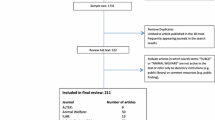Abstract
Public debate on acceptable farm animal husbandry suffers from a confusion of tongues. To clarify positions of various stakeholder groups in their joint search for acceptable solutions, the concept of animal welfare was split up into three notions: no suffering, respect for intrinsic value, and non-appalling appearance of animals. This strategy was based on the hypothesis that multi-stakeholder solutions should be based on shared values rather than on compromises. The usefulness of such an artificial value distinction strategy was tested in a small series of experiments. The results demonstrate that the chosen concept to distinguish between values is effective in a stakeholder context. Farmers’ views on doing good to animals appeared to be largely based on their value to prevent suffering and predominantly focused on the provision of regular care. Their priority for this value is clearly shared with other stakeholders, providing a basis for joint solutions. The concept of intrinsic value does not play a discernable role in farmers’ considerations. Based on the varying views on welfare, it can be inferred that there is a gradual rather than a principal difference between government legislation and farmers’ values, whereas public perception and acceptance of farm practices remains complicated. Distinction between value groups and focusing on a selected notion (such as no suffering) proved to be effective in bringing representatives of stakeholder groups together, but is unlikely to bridge the emotional gap between commercial farm practices and public ideals.
Similar content being viewed by others
References
InstitutionalAuthorNameAnonymous (2001) ArticleTitle“Scientists’ Assessment of the Impact of Housing and Management on Animal Welfare” Journal of Applied Animal Welfare Science 4 1–52 Occurrence Handle10.1207/S15327604JAWS0401_2
Broom, D. M. (1999), “Animal Welfare: The Concept of the Issues,” in F. L. Dolins (ed.), Attitudes to Animals, Cambridge University Press, pp. 129–142.
Beekman, V., J. C. Dagevos, C. N. van der Weele, and K. H. de Greef (2003), “Diergericht ontwerpen. Consumentenwensen rond dierenwelzijn,” [Animal Oriented Design. Consumer Desires Regarding Animal Welfare] Wageningen-UR, Report ID03/3557.
Bracke, M. B. M., (2001), Modeling of Animal Welfare: The Development of a Decision Support System to Assess the Welfare Status of Pregnant Sows, PhD Thesis, Wageningen University.
M. B. M. Bracke K. H. Greef Particlede H. Hopster (2004) ArticleTitle“Qualitative Stakeholder Analysis for the Development of Sustainable Monitoring Systems for Farm Animal Welfare” Journal of Agricultural and Environmental Ethics 18 27–56
de Greef, K. H., F. R. Stafleu, and S. Dudink (2004), “A Note on Actor Views on Animal Welfare: Are Respect for Animals and Animal Welfare Full Synonyms for Farmers?” in J. de Tavernier and S. Aerts (eds.), Science, Ethics and Society, 5th Congress of the European Society for Agricultural and Food Ethics, CABME, Leuven.
de Greef, K. H., W. G. P. Schouten, C. M. Groenestein, R. G. ten Hoope, and M. de Jong (2003), “Husbandry Systems from the Animal’s Point of View: Pigs,” in Y. van der Honing (ed.), Book of Abstracts of the 54th Annual Meeting of the European Association for Animal Production, EAAP/Wageningen Academic Publishers.
J. Grin F. Felix A. P. Bos S. F. Spoelstra (2004) ArticleTitle“Practices for Reflexive Design: Lessons from a Dutch Programme on Sustainable Agriculture” International Journal on Foresight and Innovation Policy 1 126–149
Stafleu, F. R., C. C. de Lauwere, and K. H. de Greef (2004), “Respect for Functional Determinism. A Farmers Interpretation of Respect for Animals,” in J. de Tavernier and S. Aerts (eds.), Science, Ethics and Society, 5th Congress of the European Society for Agricultural and Food Ethics, CABME, Leuven.
Tavernier, J. de (2001), “Visies op dierenwelzijn,” in G. Cazaux, (ed.), Mensen en andere dieren. Hun onderlinge relaties meervoudig bekeken, Garant, Apeldoorn, pp. 77–91.
Verhoog, H. (2000), “Defining Positive Welfare and Animal Integrity,” in M. Hovi and R. Garcia Trujillo (eds.), Diversity of Livestock Systems and Definition of Animal Welfare, Proceedings of the Second AHWOA Workshop Cordoba, 8–11 January 2000.
Wemelsfelder, F. (1999), “The Problem of Animal Subjectivity and its Consequences for the Scientific Measurement of Animal Welfare,” in F. L. Dolins (ed.), Attitudes to Animals, Cambridge University Press, pp. 37–53.
Welfare quality (2004), Integration of Animal Welfare in the Food Quality Chain: From Public Concern to Improved Welfare and Transparent Quality. EU, Framework program 6, running project http://www.welfarequality.net., April 2005.
Author information
Authors and Affiliations
Corresponding author
Rights and permissions
About this article
Cite this article
De Greef, K., Stafleu, F. & De Lauwere, C. A Simple Value-Distinction Approach Aids Transparency in Farm Animal Welfare Debate. J Agric Environ Ethics 19, 57–66 (2006). https://doi.org/10.1007/s10806-005-4527-1
Accepted:
Issue Date:
DOI: https://doi.org/10.1007/s10806-005-4527-1



